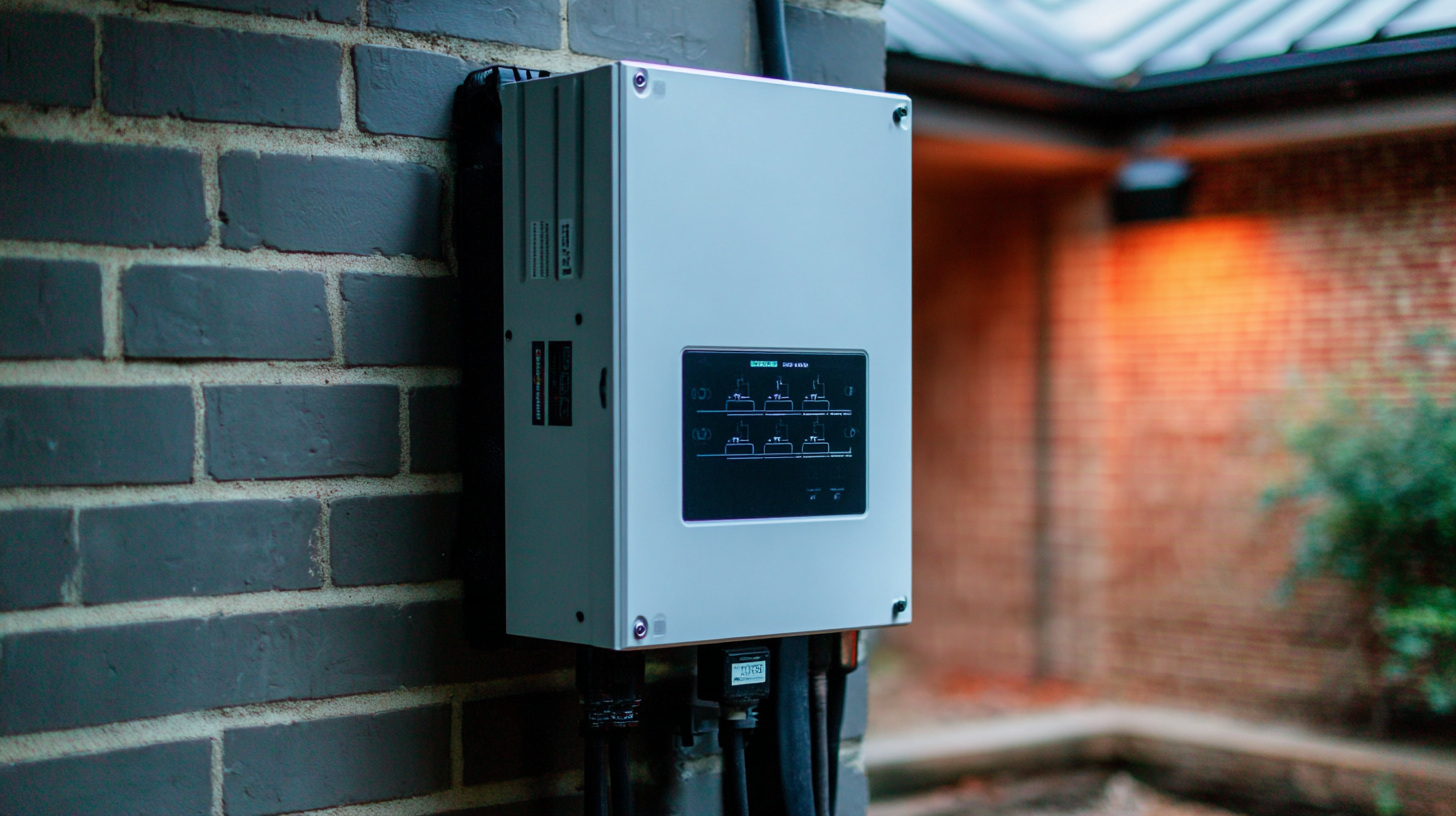Factory Tour
Maximizing Home Efficiency: How Wall-Mounted Energy Storage Batteries Revolutionize Residential Power Management
In recent years, the demand for efficient energy management solutions has skyrocketed, with the global market for residential energy storage systems projected to reach $23.4 billion by 2027, according to a report by Allied Market Research. At the forefront of this revolution are Wall-Mounted Energy Storage Batteries, which offer homeowners a versatile means to optimize their energy consumption and minimize costs. These innovative systems allow for the seamless integration of renewable energy sources, enabling households to store excess energy generated from solar panels and use it during peak hours, thus maximizing their energy independence. Furthermore, as residential electricity prices continue to rise, the adoption of Wall-Mounted Energy Storage Batteries is becoming increasingly essential, with a projected compound annual growth rate (CAGR) of 23% from 2021 to 2028 in the energy storage sector. Through enhanced efficiency and reliability, these systems are redefining how homeowners manage their power, paving the way for a more sustainable future.

Enhancing Home Energy Efficiency with Wall-Mounted Battery Solutions
As homeowners increasingly seek ways to optimize energy usage, wall-mounted battery solutions have emerged as a game-changer in enhancing energy efficiency. These compact systems allow for the storage of energy generated from renewable sources, such as solar panels, creating an intelligent buffer against grid dependence. According to a report by the International Energy Agency, residential batteries can help households save up to 30% on energy bills by storing excess energy during off-peak hours and drawing from this reserve when energy costs are higher.
Adopting wall-mounted energy storage systems not only improves efficiency but can also increase the resilience of the home’s energy supply. In regions prone to power outages, these batteries ensure that critical appliances remain operational. Additionally, research from the Energy Storage Association indicates that incorporating a wall-mounted battery can reduce a household's carbon footprint by more than 50% over a decade, highlighting the significant environmental benefits of such systems.
Tips for Maximizing Home Energy Efficiency:
- Consider installing solar panels alongside your wall-mounted battery to enhance energy production and storage capabilities.
- Utilize smart home technology to schedule appliance usage during off-peak hours, further leveraging stored energy and decreasing reliance on the grid.
- Regularly monitor your energy consumption patterns to identify areas for improvement and ensure your battery is effectively optimizing your energy usage.
Key Advantages of Wall-Mounted Energy Storage for Homeowners
 Wall-mounted energy storage batteries are transforming residential power management, offering a range of benefits that enhance home efficiency. One of the primary advantages is the ability to store surplus energy generated from renewable sources, such as solar panels. According to a report by the U.S. Department of Energy, homes equipped with solar energy systems that integrate battery storage can see energy bill savings of up to 75%. This not only reduces reliance on grid power but also allows homeowners to maximize their return on investment in renewable energy technology.
Wall-mounted energy storage batteries are transforming residential power management, offering a range of benefits that enhance home efficiency. One of the primary advantages is the ability to store surplus energy generated from renewable sources, such as solar panels. According to a report by the U.S. Department of Energy, homes equipped with solar energy systems that integrate battery storage can see energy bill savings of up to 75%. This not only reduces reliance on grid power but also allows homeowners to maximize their return on investment in renewable energy technology.
Moreover, wall-mounted battery systems provide homeowners with enhanced energy security and resilience. During outages, these batteries can supply power to essential appliances, ensuring safety and comfort. The Energy Storage Association reports that the adoption of residential energy storage solutions has increased by over 200% in the last three years, reflecting a growing recognition of their importance in energy management. This trend highlights the evolving landscape of home energy systems, where wall-mounted batteries play a crucial role in not just reducing costs but also improving energy independence for homeowners.
Integrating Renewable Energy Sources with Your Storage Battery
Integrating renewable energy sources with wall-mounted energy storage batteries offers a transformative solution for residential power management. By utilizing solar panels or small wind turbines in combination with these storage systems, homeowners can create a self-sufficient energy ecosystem. The energy generated during peak sunlight hours or windy conditions can be stored efficiently, allowing households to draw on this power during times of low production, such as at night or during cloudy days. This not only maximizes energy efficiency but also reduces reliance on the grid, leading to potential cost savings on utility bills.
Moreover, the compatibility of these batteries with various renewable technologies enhances the resilience and sustainability of home energy systems. Wall-mounted batteries can seamlessly integrate with smart home technologies to monitor energy production and consumption in real-time, optimizing usage patterns. Such integration empowers homeowners to actively manage their energy flows, ensuring that they utilize renewable sources effectively while minimizing waste. As the demand for clean energy options grows, these innovative solutions will play a crucial role in enabling households to significantly lower their carbon footprint and achieve energy independence.

Effective Strategies for Maximizing Your Home's Energy Storage System
The integration of wall-mounted energy storage batteries in residential settings represents a significant advancement in home efficiency management. To maximize the benefits of this technology, homeowners can implement several effective strategies. Firstly, it is crucial to assess energy consumption patterns. Understanding when and how energy is used can inform decisions about when to charge the battery and when to draw power from it, thereby minimizing reliance on the grid during peak hours when electricity rates are highest.
Another key strategy involves optimizing the use of renewable energy sources, such as solar panels. By synchronizing battery charging with solar energy production, homeowners can store excess power for use during the evening or on cloudy days. Additionally, engaging in load management—prioritizing energy usage based on availability—ensures that critical devices remain powered while minimizing energy costs. By combining these approaches, homeowners can vastly improve their energy resilience and reduce overall utility expenses.
Maximizing Home Efficiency: How Wall-Mounted Energy Storage Batteries Revolutionize Residential Power Management
| Aspect | Description | Benefits | Considerations |
|---|---|---|---|
| Energy Capacity | Amount of electricity the battery can store, measured in kilowatt-hours (kWh). | Allows for more extended use of stored energy, reducing reliance on the grid. | Higher capacity batteries tend to be more expensive. |
| Charge Cycles | The number of times a battery can be charged and discharged without significantly degrading. | Longer lifespan and better return on investment. | Depends on the type of battery technology used. |
| Integration with Solar | The ability to pair with solar panel systems for seamless performance. | Maximizes renewable energy usage and reduces electricity bills. | Requires additional setup and investment in solar infrastructure. |
| Smart Management Systems | Use of technology to optimize when to store and when to use energy. | Enhances efficiency and can lead to significant cost savings. | Requires initial setup and understanding of the system’s features. |
| Environmental Impact | The effect of battery production, use, and disposal on the environment. | Can lead to lower carbon footprints when paired with renewable energy. | Differing materials and recycling processes can affect sustainability. |
Future Trends in Residential Energy Management and Battery Technology
The future of residential energy management is poised for transformative change, driven largely by advancements in battery technology. As households increasingly incorporate renewable energy sources, such as solar panels, the need for effective energy storage solutions becomes paramount. Wall-mounted energy storage batteries are emerging as a critical component of this evolution, allowing homeowners to optimize their energy use. These compact systems not only store excess energy generated during peak sunlight hours but can also provide a reliable backup during outages, enhancing energy independence.
In addition to providing immediate benefits to energy management, future trends indicate that battery technology will become increasingly integrated with smart home systems. This integration will enable real-time monitoring and adjustments based on user behavior and energy consumption patterns. Additionally, developments in energy management software will allow for predictive analytics, ensuring that battery usage is maximized based on anticipated energy needs. As battery efficiency improves and costs decrease, it is expected that more households will adopt these technologies, paving the way for a more sustainable and resilient energy future.
Maximizing Home Efficiency: Wall-Mounted Energy Storage Battery Capacity Over Time
Related Posts
-

Exploring Innovative Alternatives to Wall Mounted Energy Storage Batteries
-

Discover Unmatched Opportunities in Floor Standing Energy Storage Battery at the 137th Canton Fair
-

Crafted Excellence: The Global Rise of China's Premier Wall-Mounted Energy Storage Solutions
-

Innovative Solutions for Wall-Mounted Energy Storage Batteries
-

Elevate Your Energy Solutions with the Best Household Energy Storage Battery from China's Premier Manufacturers
-

Unveiling the Hidden Challenges in Household Energy Storage Battery Solutions







